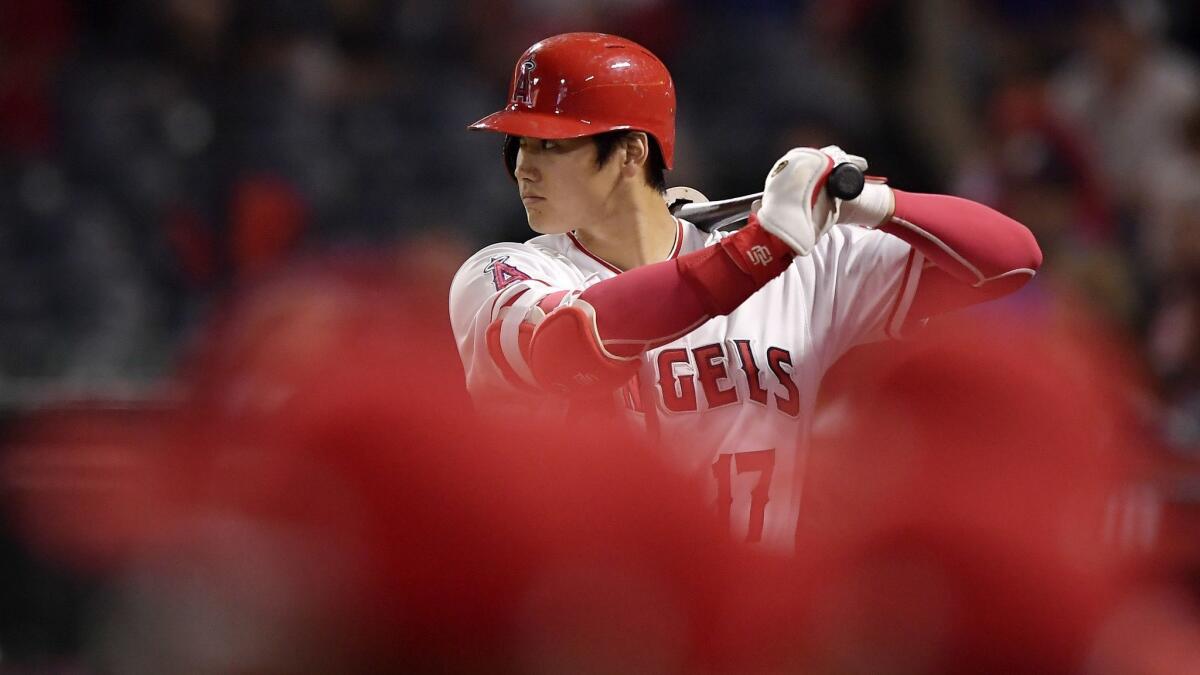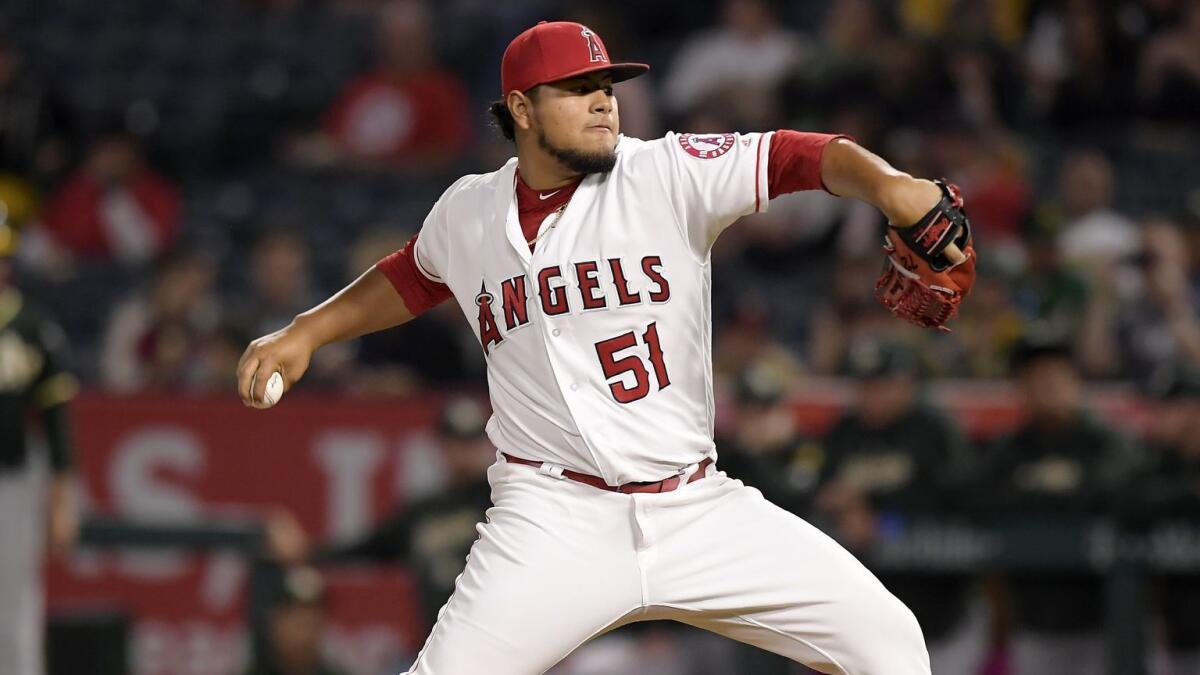Will new Angels coaches be a hit? ... and other spring training questions

- Share via
Reporting from Tempe, Ariz. — Here comes the Brad Ausmus Era.
For the first time this century, the Angels report to spring training with a manager not named Mike Scioscia. There will be a lot of attention on what Ausmus does to alter the baseball landscape in Anaheim.
But there are other issues and topics to monitor as pitchers and catchers convene Tuesday for physicals and the 2019 season approaches. Here are a few:
What kind of influence will new hitting coaches wield?
The changes general manager Billy Eppler made to the Angels’ major league staff were deeply rooted in analytics. Last season, the Angels were just above average in slugging percentage (.413) and ranked seventh in home runs (214), but their 721 runs was 15th in baseball. They hit only .252 with runners on base.
With the need to improve offensive efficiency in mind, Eppler promoted minor league hitting coordinators Jeremy Reed and Shawn Wooten to the major league staff. Both earned praise from their pupils.
They demonstrated the ability to weave advanced technology into their instruction without stripping hitters of their instincts. Top prospect Jo Adell, who earned his first invitation to major league spring training, ascribed his ability to advance three levels last year in his first full professional season in part to their grasp of analytics and understanding of hitting. Outfielder Kole Calhoun also credited their teachings when he busted out of last year’s season-long slump in August.
Reed and Wooten will be tasked with improving hitters’ comprehensions of technology-driven approaches and overseeing new catcher Jonathan Lucroy’s resurgence. The veteran, who batted .241 with a .291 on-base percentage that ranked 11th of 15 catchers with at least 400 plate appearances last year, spent the offseason tweaking his timing in the batter’s box in search of a return to All-Star form.
How will Ohtani progress?
Two-way player Shohei Ohtani, the American League rookie of the year, had elbow ligament-replacement surgery on his throwing arm in October and was cleared in late January to resume strength training on his right side. But his return to the Angels lineup, where he is expected to spend most of the season as the designated hitter, will not occur opening day.
Ohtani’s recovery from the surgery is unique. He cannot follow a normal progression in rehabilitation because he has to prepare to return to full strength as a hitter this season and as a pitcher in 2020.
Most hitters who have the surgery can return to competitive situations within seven months. Ohtani is already halfway there.
The Angels won’t make any hitting predictions about Ohtani, who bats from the left side and throws from the right, because his daily routines will also require getting his pitching elbow into shape. However, there is a solid chance he will rejoin the team in time to accrue 400 at-bats.
If not, the Angels still have Albert Pujols and Justin Bour to split the duties.
What shape will the pitching staff take?
The Angels have a bevy of arms, something that has become necessary for an organization that has faced an abnormal amount of health concerns since Eppler took over before the 2016 season. But with that number comes a predicament: Who gets a spot on the 25-man roster?
The Angels rotation will feature left-handers Tyler Skaggs and Andrew Heaney, and veterans Matt Harvey and Trevor Cahill. Right-hander Jaime Barria, who struck out 98 batters over 26 starts as a 22-year-old rookie last year, is the likely front-runner for the fifth rotation spot. The Angels also have starters Felix Pena, Nick Tropeano, prospect Griffin Canning and newcomer Dillon Peters in camp.
Canning, who reached triple A last year, would be a long shot for the opening-day roster. Pena and Tropeano have handled rotation assignments with competence.

Peters served as a swing man during his time with the Miami Marlins, which puts him in line to compete for a similar role this year. Pena and Tropeano will probably factor into that conversation as well.
While solving that conundrum, Eppler and company will also have to decide on roles for relievers Cody Allen, Justin Anderson, Ty Buttrey, Williams Jerez, Hansel Robles, John Curtiss, Cam Bedrosian, Daniel Hudson, Taylor Cole, Luis Garcia, Jake Jewell and Noe Ramirez.
Jerez, Robles, Buttrey and Jewell still have minor league options remaining. Such flexibility could help alleviate the Angels’ roster crunch.
What is next for Mike Trout?
It is a common perception that everything Eppler does falls in line with a larger plan to entice perennial MVP candidate Mike Trout to sign a contract extension with the Angels.
Eppler denies it and says he is instead focused on solidifying the major league roster while simultaneously improving the Angels’ once-depleted farm system, which enters the season ranked among the top 10 in baseball according to several publications. Among his top acquisitions in recent seasons are Gold Glove shortstop Andrelton Simmons, outfielder Justin Upton, infielder Zack Cozart and second base prospect Luis Rengifo.
However, the Angels have missed the postseason and failed to reach the .500 mark in each of Eppler’s last three years as GM.
This season is Eppler’s last under contract. He has improved the overall health of the organization and seemingly set the Angels up for long-term success. Will that be enough to keep Trout, whose contract is set to expire after the 2020 season, in Anaheim and to net Eppler his own extension?
Sign up for our daily sports newsletter »
More to Read
Go beyond the scoreboard
Get the latest on L.A.'s teams in the daily Sports Report newsletter.
You may occasionally receive promotional content from the Los Angeles Times.







